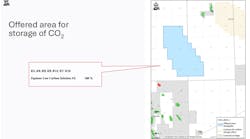UK government draws up shortlist for second-stage carbon capture process
Offshore staff
LONDON – Britain’s government has shortlisted 20 projects for the next stage of its carbon capture utilization and storage (CCUS) clusters process.
The UK is thought to hold one of the largest potential CO2 subsurface storage capacities in Europe, mostly in the North Sea.
A government’s commitment to support CCUS UK-wide could help create 50,000 jobs nationally by 2030.
The new shortlist follows the commitment in the Ten Point Plan for a Green Industrial Revolution to deploy CCUS in two industrial clusters by the mid-2020s and a further two by 2030.
Last November, the HyNet cluster in North West England and North Wales (which includes the Liverpool Bay offshore fields), and the East Coast Cluster in the Teesside and Humber in northeast England were designated Track 1 clusters, for deployment by the mid-2020s.
They will also be the first to be considered for support under the government’s CCUS program, which includes the £1 billion (US$1.21 billion) CCS Infrastructure Fund (CIF). The shortlisted projects will also be in the running for government funding support to join one of these clusters, to use carbon capture technology to help decarbonize their businesses.
Today’s announced list is said to represent a range of innovative CCUS technologies that will capture carbon emissions, preventing them being released into the atmosphere. Carbon capture technologies can help attract new private investment and support new job opportunities to the included regions.
POWER CCUS
East Coast Cluster
Net Zero Teesside Power
Whitetail Clean Energy
Keadby 3 Carbon Capture Power Station
HYDROGEN
East Coast Cluster
bpH2Teesside
H2NorthEast
Hydrogen to Humber (H2H) Saltend
HyNet
HyNet Hydrogen Production Project (HPP)
INDUSTRIAL CARBON CAPTURE
East Coast Cluster
CF Fertilisers Billingham Ammonia CCS
Tees Valley Energy Recovery Facility Project (TVERF)
Norsea Carbon Capture
Redcar Energy Centre
Teesside Hydrogen CO2 Capture
Humber Zero – Phillips 66 Humber Refinery
Prax Lindsey Oil Refinery Carbon Capture Project
ZerCaL250
HYNET
Hanson Padeswood Cement Works carbon capture and storage project
Viridor Runcorn Industrial CCS
Protos Energy Recovery Facility
Buxton Lime Net Zero
Carbon Dioxide Capture Unit – EssarOil UK
Equinor has responded to its Hydrogen to Humber Saltend (H2H Saltend) production facility being one of those selected under Phase 2 of the cluster sequencing process.
The selected projects will now proceed to the process’ due diligence stage, allowing them to connect to the East Coast Cluster’s CO2 transport and storage infrastructure and be operational in the mid-2020s.
Equinor was also successful with its bids for two new gas-fired power stations with carbon capture at Keadby (developed with SSE Thermal) and in Teesside (a partnership with bp).
But the company considers H2H Saltend its flagship project with a 600-MW low carbon hydrogen production plant, located at the Saltend Chemicals Park (SCP), east of Hull.
The Humber is said to be the UK’s most carbon-intensive industrial region; H2H Saltend, Equinor claimed, could allow various industries at SCP and across the wider East Yorkshire area to cut their CO2 emissions by nearly 1 MM metric tons annually.
Projects that are finally selected will start operations in 2026-2027.
In addition, Equinor plans a second 1.2-GW low-carbon hydrogen production facility in the Humber, which combined with H2H Saltend could deliver 18% of the government’s targeted 10-GW hydrogen production capacity by 2030.
Further plans with SSE Thermal cover what could be the world’s first at-scale 100% hydrogen power station at Keadby and a hydrogen storage facility at Aldbrough.
08.12.2022



